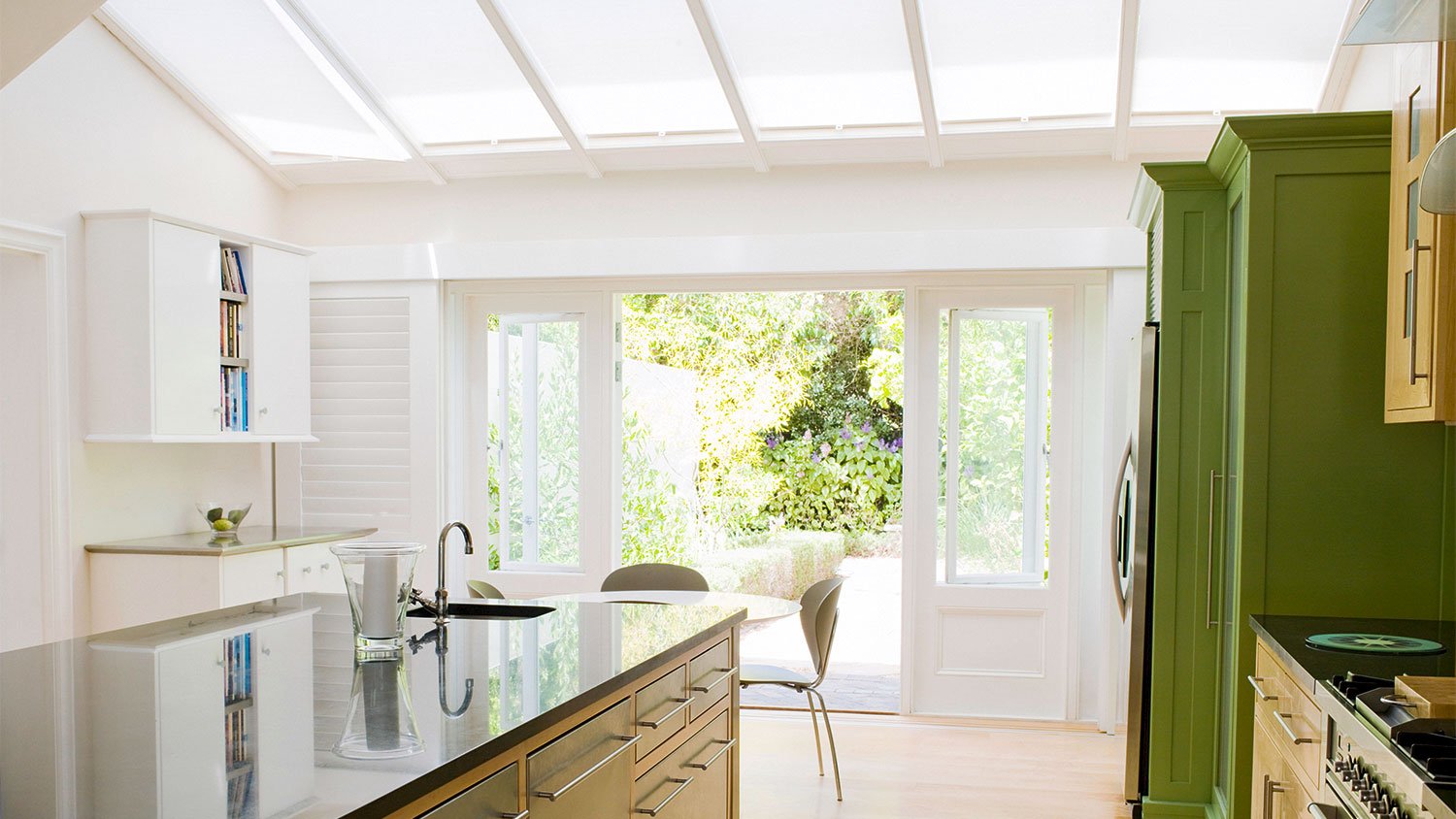Should I Install a Skylight Over My Kitchen Island? Pros, Cons, Cost, and More
Let the sunshine in


The main types of skylights are fixed, vented, and tubular.
The materials used include glass or plastic glazing.
The structural conditions of your home have to be right.
You should hire a professional to install your skylight.
It costs an average $1,700 to install a skylight.
Who doesn’t love a sunny kitchen? If you’re looking to brighten up your kitchen space, a skylight is great for bringing in natural light and even fresh air, depending on the window you choose. And placing it above your island could really make the room feel airy and bright.
Of course, there are several considerations to make beforehand, from the type and size of the window to its optimal placement and direction. Wondering whether you should install a skylight over your kitchen island? You’ve come to the right place.
What Are the Main Types of Skylights?
Skylights come in a range of sizes and shapes, including oval, diamond, rectangular, circular, triangular, and more. There are three main types: fixed, vented, and tubular. In addition, you’ll want to consider whether plastic or glass glazing is right for you.
Fixed
This is the most popular (and most basic) type of skylight. It can’t be opened and thus does not provide ventilation. If you only want additional light over your kitchen island, a fixed window is a good option.
Vented
You can open vented skylights to add both fresh air and light to a room. This type of window is ideal for the kitchen since it provides ventilation.
Tubular
A tubular skylight is domed and paired with a reflective metal tube to provide daylight without losing heat at night or gaining heat during the day. Tubular skylights don’t provide ventilation or a view. If your main goal is to save money on your utility bill, this type of skylight is a good bet.
Glass vs. Plastic Glazing
In terms of material, you have your pick of two options: plastic and glass. Plastic can be either acrylic or polycarbonate, and it’s generally less expensive than glass. Glass glazing does tend to be more durable, and it doesn’t discolor like plastic does.

What Should I Know Before Installing a Skylight?
Before installing a skylight over your kitchen island, it’s important to consider the construction of your roof and the direction of the light. The physical size of the skylight affects the light and temperature of the space.
You’ll also want to know how to avoid water leaks, which is a common problem with incorrectly installed skylights. Because installation requires such precision and professional knowledge, it’s not recommended for the average DIYer.
Here’s what you need to know to pick the right skylight for your home.
Energy Performance Ratings
For the most energy-efficient light, look for the National Fenestration Rating Council (NRFC) and ENERGY STAR labels.
Size
As a general rule, the size of your skylight should never be more than 5% of the floor area in rooms with many windows. It should be no more than 15% of the room’s total floor area for spaces with few windows.
Roof Structure
The structure of your roof matters greatly when it comes to skylight installation. A qualified local roofing contractor can help you inspect the roof to make sure your skylight can be safely installed above your kitchen.
Location
Consider the location of your skylight if you want to maximize daylight and solar heat gain. If you want to avoid glare, installation in a north-facing roof slope is ideal.
Windows on east-facing roofs provide maximum light and heat gain in the morning, while west-facing skylights provide sunlight and heat gain in the afternoon. South-facing skylights provide extra heat during the winter but often allow for unwanted heat gain in the summer.
Moisture Control
To avoid potential water leaks, it’s helpful to mount the skylight above the roof surface, thoroughly seal the joints, and install a curb and flashing.
Warranty
Skylights generally last between 20 and 40 years, as long as they’re high-quality and professionally installed. Be sure that both product and installation are covered by a warranty in case your window fails for some reason before then.
Pros of a Skylight Over a Kitchen Island

Because of their ability to bring natural light into a room, skylights are often a great addition to the kitchen.
Natural Light and Warmth
One of the biggest advantages of a skylight over a kitchen island is that it brings extra daylight and warmth into the space. The look and feel of a sun-drenched kitchen is especially nice during wintertime.
Energy Savings
You may be able to get away with using less heat and artificial light, resulting in savings on your next electric bill.
Aesthetics
Skylights have the potential to dramatically enhance the aesthetics of your kitchen space.
Cons of a Skylight Over a Kitchen Island
While skylights have many benefits, they may not be the right choice for every home.
Potential Installation Problems
Skylight installation is complex. If a skylight isn’t correctly installed, this could lead to moisture problems and major leaks.
Too Much Light
Depending on the size and direction of your window, it could bring too much heat and light into your space. (This is why it’s so important to carefully consider size, placement, and direction before installing a skylight.)
Heat Loss
Skylights often lose heat during cooler months. (Though homeowners can combat this by making sure that the glass is insulated.)
Is a Skylight Worth the Price?
According to HomeAdvisor, it costs an average of $1,700 to install a skylight. A typical price range is said to be between $1,000 and $2,600. That said, skylight costs vary widely. Contact a skylight installer for an exact quote, so that you can determine whether this type of window is within your budget.














